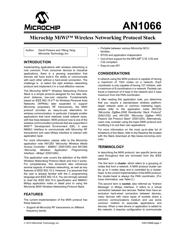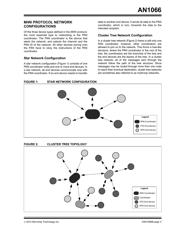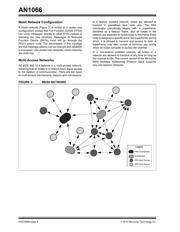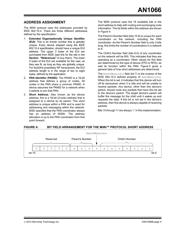Datasheet 搜索 > 8位微控制器 > Microchip(微芯) > PIC16C54C-20/P 数据手册 > PIC16C54C-20/P 开发手册 4/22 页

 器件3D模型
器件3D模型¥ 18.81
PIC16C54C-20/P 开发手册 - Microchip(微芯)
制造商:
Microchip(微芯)
分类:
8位微控制器
封装:
DIP-18
描述:
MICROCHIP PIC16C54C-20/P 微控制器, 8位, 一次性可编程, PIC16C5xx, 20 MHz, 768 Byte, 25 Byte, 18 引脚, DIP
Pictures:
3D模型
符号图
焊盘图
引脚图
产品图
页面导航:
技术参数、封装参数在P18
导航目录
PIC16C54C-20/P数据手册
Page:
of 22 Go
若手册格式错乱,请下载阅览PDF原文件

AN1066
DS01066B-page 4 © 2010 Microchip Technology Inc.
Mesh Network Configuration
A mesh network (Figure 3) is similar to a cluster tree
configuration, except that Full Function Device (FFDs)
can route messages directly to other FFDs instead of
following the tree structure. Messages to Reduced
Function Device (RFDs) must still go through the
RFD’s parent node. The advantages of this topology
are that message latency can be reduced and reliability
is increased. Like cluster tree networks, mesh networks
are multi-hop.
Multi-Access Networks
An IEEE 802.15.4 network is a multi-access network,
meaning that all nodes in a network have equal access
to the medium of communication. There are two types
of multi-access mechanisms: beacon and non-beacon.
In a beacon enabled network, nodes are allowed to
transmit in predefined time slots only. The PAN
coordinator periodically begins with a superframe,
identified as a beacon frame, and all nodes in the
network are expected to synchronize to this frame. Each
node is assigned a specific slot in the superframe, during
which, it is allowed to transmit and receive its data. A
superframe may also contain a common slot during
which all nodes compete to access the channel.
In a non-beacon enabled network, all nodes in a
network are allowed to transmit at any time as long as
the channel is Idle. The current version of the Microchip
MiWi Wireless Networking Protocol Stack supports
only non-beacon networks.
FIGURE 3: MESH NETWORK
PAN Coordinator
FFD End Device
RFD End Device
Coordinator
Legend
器件 Datasheet 文档搜索
AiEMA 数据库涵盖高达 72,405,303 个元件的数据手册,每天更新 5,000 多个 PDF 文件






